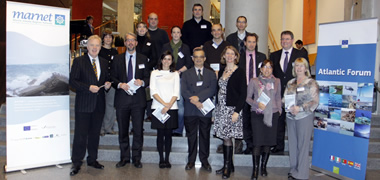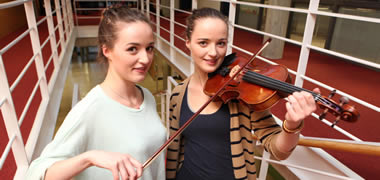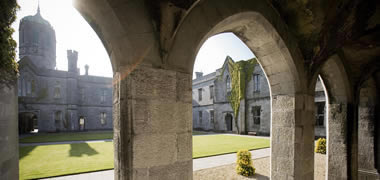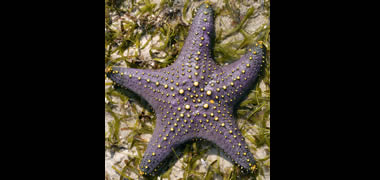-
Courses

Courses
Choosing a course is one of the most important decisions you'll ever make! View our courses and see what our students and lecturers have to say about the courses you are interested in at the links below.
-
University Life

University Life
Each year more than 4,000 choose University of Galway as their University of choice. Find out what life at University of Galway is all about here.
-
About University of Galway

About University of Galway
Since 1845, University of Galway has been sharing the highest quality teaching and research with Ireland and the world. Find out what makes our University so special – from our distinguished history to the latest news and campus developments.
-
Colleges & Schools

Colleges & Schools
University of Galway has earned international recognition as a research-led university with a commitment to top quality teaching across a range of key areas of expertise.
-
Research & Innovation

Research & Innovation
University of Galway’s vibrant research community take on some of the most pressing challenges of our times.
-
Business & Industry

Guiding Breakthrough Research at University of Galway
We explore and facilitate commercial opportunities for the research community at University of Galway, as well as facilitating industry partnership.
-
Alumni & Friends

Alumni & Friends
There are 128,000 University of Galway alumni worldwide. Stay connected to your alumni community! Join our social networks and update your details online.
-
Community Engagement

Community Engagement
At University of Galway, we believe that the best learning takes place when you apply what you learn in a real world context. That's why many of our courses include work placements or community projects.
2012
All 2012
NUI Galway Researchers Launch Marine Atlantic Regions Network Project

Thursday, 15 November 2012
Researchers from NUI Galway, along with members of the Border, Midland and Western (BMW) Regional Assembly, officially launched the new MARNET project at a major EU Commission Marine conference in Bilbao, Spain earlier this week. MARNET (Marine Atlantic Regions Network) is a three year co-operation project involving regional authorities and marine socio-economists in Ireland, Spain, France, Portugal and Scotland. The initiative will establish an EU Atlantic Marine Socio-Economic Network that will map the value of the Atlantic Marine economy through the development of reliable and comparable socio-economic data throughout Atlantic Regions. Socio-Economic Marine Research Unit (SEMRU) in NUI Galway is the lead scientific partner on this large scale EU INTERREG project. SEMRU, created in NUI Galway in 2008 with the support of the Marine Institute Beaufort Marine Socio-Economic Award, is focused on economic and social research to quantify the economic importance of Ireland’s marine environment in support of ‘evidence-based’ policy development within the marine sector. Attending the launch, Dr Frances Fahy, Lecturer in Geography at NUI Galway and MARNET researcher, said: “The main aim of the MARNET project is to develop a Marine Atlantic Regions Network and to establish formal co-operative links between marine socio-economic research institutions and other bodies operating in the European Atlantic coastal zone.” Assembly Director Gerry Finn welcomed the EU Commission's support for the MARNET project adding: “MARNET is an important development in Maritime co-operation in Atlantic Regions. The availability of comparable socio-economic data in the sector is vital to targeting future funds to niche areas of the Marine Economy. I am delighted that the BMW Regional Assembly is in a position to co-ordinate this exercise which up to this point has not been achieved at an EU level. I look forward to the engagement of local authorities and industry representatives in the project who will identify specific practical initiatives for the sector. This initiative complements the recently launched Marine strategy for Ireland 'Our Ocean Wealth' which aims to realise the significant potential of the marine sector to contribute to job creation and economic development in Ireland.” MARNET was presented to over 150 delegates from throughout the Atlantic Region at an EU Forum Conference event in Bilbao, Spain. The consultation seminar was organised by DG MARE of the EU Commission as part of the development of the EU Maritime Strategy for the Atlantic Area. The key note address was delivered by President of the Poitou Charentes Regional Council, Ms Segolene Royal who was a candidate for the presidency of France in 2007. -ENDS-
>> Read full story about NUI Galway Researchers Launch Marine Atlantic Regions Network Project
NUI Galway Medical Orchestra Perform for Patients in Sligo and Mayo

Friday, 16 November 2012
The NUI Galway Medical Orchestra will give two concerts in Mayo and Sligo Hospitals this month. The concerts will take place on Saturday, 24 November at 6pm in the Hume Hall, Sligo IT and on Sunday afternoon, 25 November at 2pm at Mayo General Hospital (St. Mary’s Hall) in Castlebar. Entitled ‘The Maureen Woods Memorial Concerts’, students will perform for the patients and medical staff of both hospitals, to invited guest musicians from the medical academy of Sligo and Mayo and also to invited members of the public. Both performances are free, thanks to the benefactors, the Woods family of Tarmon Co. Leitrim. The concerts by the NUI Galway Medical Orchestra celebrate much of what Maureen Woods loved and believed in – the healing power of music, the essential role of the arts in medicine, and the close bonds between the creative instinct and the best of science and medicine. Speaking in advance of the performance in Castlebar, Kevin Barry, Dean, Mayo Medical Academy, said: “I am delighted that NUI Galway Medical Orchestra is coming to perform at Mayo General Hospital/Mayo Medical Academy. This is a unique opportunity to celebrate the cultural, spiritual and healing powers associated with music. We have long recognised the importance of the arts in promoting patient welfare. The Arts Committee at Mayo General Hospital has for example, hosted many wonderful exhibitions at our hospital over the years including the works of our patients. NUI Galway Medical Orchestra is a fantastic initiative and the various student members are to be congratulated for their dedication and strength of character. I look forward to a great afternoon of entertainment. This is a most inspiring event.” Dr Geraldine McCarthy, Dean of Sligo Medical Academy, said: “Sligo Medical Academy and Sligo Regional Hospital are delighted to welcome the NUI Galway Medical Orchestra to Sligo for their concert for hospital staff and patients. It is a wonderful initiative linking the arts and health and the students have been great ambassadors for Galway Medical School.” The NUI Galway Medical Orchestra is made up solely of medical students from across Clinical Sciences to include medical students as well as students from Nursing, Midwifery and the Therapies. One of the ground breaking initiatives of Clinical Sciences at NUI Galway under Professor Fidelma Dunne, Head of School and Dr Gerard Flaherty, Senior Lecturer in Clinical Medicine, is to offer formal academic credit to medical students who choose to join the orchestra special study module. The arranger and musical director is the well-known musician Carl Hession and the producer of the orchestra is Mary McPartlan of NUI Galway and originally from Drumkeerin, Co. Leitrim. Speaking of the initiative, Professor Fidelma Dunne, Head of School at Clinical Sciences, said: “This is an excellent performance opportunity for the students involved, as well as recognising the benefits of music and the importance of the creative arts in the development of young students studying medicine, the holistic nature of their endeavour and the integrity it embeds into their lives as healthcare professionals. I would particularly like to thank the family of Maureen Woods for helping to make these two concerts possible through their generous sponsorship of these two concerts in Sligo and Castlebar.” The Medical Orchestra at NUI Galway has been in existence for over a year and it has already established itself as a very positive initiative with a number of high profile public performances. The orchestra is open to students across the Schools of Medicine, Nursing & Midwifery and Health Sciences and students may select the orchestra to attain academic credit or simply participate for their personal satisfaction, enjoyment and development. ENDS
>> Read full story about NUI Galway Medical Orchestra Perform for Patients in Sligo and Mayo
New Diabetes Research Centre for the West

Friday, 16 November 2012
9.6% of Irish Population with Diabetes Diabetes is now the commonest metabolic illness in the world and earlier this week marked World Diabetes Day (Wednesday, 14 November). An estimated 9.6% of the Irish population now have the disease. With a particularly high prevalence in the Western Region of the country, NUI Galway and Galway and Roscommon University Hospital Group have joined forces to create the Galway Diabetes Research Centre. The Galway Diabetes Research Centre (GDRC) will bring together an interdisciplinary research consortium of active researchers and clinicians. GDRC members comprise of individuals from across the diverse disciplines including psychology, engineering, economics, health promotion, nursing, midwifery, podiatry and information technology, all of whom have a track record in the field of diabetes. Based at NUI Galway, the GDRC will link researchers from these diverse disciplines to strengthen and develop close links with clinicians from Galway and Roscommon University Hospital Group and the hospitals linked to the NUI Galway regional Medical Academies. Professor Fidelma Dunne,School of Medicine, Co-director of the GDRC explains: “This is an exciting opportunity for researchers and clinicians working in Diabetes at NUI Galway and Galway and Roscommon University Hospital Group. The centre will facilitate the development of each individual’s skills and provide the academic environment for collaboration. The collaboration between an academic institution and Health Care Delivery network will facilitate the efficient translation of research findings into clinical practice resulting in tangible benefits for patients with diabetes.” Bill Maher, CEO of the Galway and Roscommon University Hospital Group said: “This new research centre for Galway is another example of where the synergy of the Hospital and University can lead to tangible benefits for patients and improved outcomes. Diabetes is a growing health care problem which is putting additional strain on a public health service which will face funding difficulties for the foreseeable future; advances in research which lead to improved treatment and which enhance the skills of our clinicians will promote patient health and are to be welcomed.” Research clusters Through three main clusters: Aetiology and Prevention, Current and Future Clinical Management, and Population and Health Services Research, the GDRC will serve the needs of patients with diabetes mellitus and those at risk of developing diabetes mellitus by creating the treatments of the future through research, providing state of the art clinical care and developing the carers of the future through education. The three main research clusters, capitalise on the already high volume of diabetes related work undertaken by the University and hospitals. 1. Aetiology and Prevention Aetiology and Prevention contributes to our understanding of how diabetes develops and what are the underlying mechanisms. Researchers in this cluster are active at every level of disease, from genes, through to glycoproteins and stem cells. 2. Current and Future Clinical management Investigators in this strand are focused on the development of new therapies for diabetes mellitus. There is an active clinical trial programme through the HRB Clinical Research Facility, Galway, with the support of research nurses, quality assurance staff and biostatisticians. There is also a major focus on the development of biomaterials and stem cell based approaches to regenerative therapies through the Science Foundation Ireland funded research centres REMEDI and NFB. 3. Population and Health Services Research This cluster will contribute to the evidence required to help address the many challenges of health care delivery in diabetes. These challenges include changing the way services are delivered, evaluating the health care needs of the diabetes population and measuring the relative effectiveness of interventions. The GDRC will be official launched on Friday, 16 November by Dr Jim Browne, President of NUI Galway, and Mr Bill Maher, CEO Galway and Roscommon University Hospital Group. Speakers at the event will include: Professor Stephen O’Rahilly, University of Cambridge; Professor John Nolan, STENO Diabetes Centre Denmark; Professor James Shaw, Newcastle University; and Dr Peter Hammond, Harrogate District Hospital, UK. Sligo senior footballer, Mr Kenneth Sweeney also addressed the event who is 11 years living with type 1 Diabetes. Diabetes Statistics Diabetes is a chronic condition associated with significant morbidity and mortality. It is the commonest metabolic illness globally, according to the World Health Organisation, 346 million people worldwide have the condition. It is estimated that this figure will double by 2030. About 90% of all diabetes is type 2. The prevalence of type 2 diabetes is increasing at an alarming rate in tandem with rising obesity rates. In Ireland the number of people with type 2 diabetes is growing as a result of an ageing population and rising obesity rates. The Diabetes Federation of Ireland estimated that 200,000 people had diabetes in Ireland in 2003 and a further 200,000 had the condition but were unaware of it. They also estimated that a further 250,000 had pre-diabetes and 50% would develop diabetes in the ensuing 5 years if lifestyle changes were not met. The Institute of Public Health (2005) concluded that 4.7% of the population (circa 150,000) of the Republic had established diabetes, with the highest prevalence in the Western Region (5.2%). The Institute of Public Health have revised their figures again (2012) and now conclude that 9.6% of the population have Diabetes. Ends
>> Read full story about New Diabetes Research Centre for the West
Report Points to Failure of State to Vindicate Rights of Children

Friday, 16 November 2012
A report launched at NUI Galway today calls for the human rights of children of asylum seekers to be respected and criticises the current direct provision system. The situation facing hundreds of soon to be displaced asylum seekers, residents of Lisbrook House in Galway, also came in for sharp criticism. ‘Parenting in Direct Provision: Parent’s perspectives regarding stresses and supports’ was written by Helen Ogbu, a graduate of the MA in Family Support Studies in the UNESCO Child and Family Research Centre at NUI Galway. Parents interviewed in the report felt that their mental health problems and those of their childrenwere increased by prolonged stays in the centres, the strain of living in over-crowded rooms, poor diets, unavailability of recreational and study space, and the educational restriction for older children. She stated that: “Direct Provision is an unsuitable environment for children and families, that it is damaging to family life and that it is not in the best interests of the child.”Her report recommends that the policy of Direct Provision as it currently stands should be reviewed and that such communal accommodation should not be used for periods of longer than six months. The report was launched at an event hosted by NUI Galway and chaired by Professor Ray Murphy of the University’s Irish Centre for Human Rights. Opening the event Professor Murphy stated: “Of the 5,098 residents in Direct Provision, over one third are children. These children spend a significant proportion of their childhood in Direct Provision accommodation. This report indicates a failure of the state to vindicate rights set out in the UN Convention on the Rights of the Child and the family life rights set out in the European Convention on Human Rights in the case of children in the asylum system.” He added: “This is particularly shocking given the recent campaign on the amendment to the Constitution regarding children’s rights. In particular the situation for those children who have grown up and attend school in Galway, currently housed in Lisbrook House and who are to be scattered throughout the country give rise to concern on how this can be in the best interests of these children.” The audience of students, members of the public and asylum seekers also heard from Sade, an asylum seeker who has been living in the direct provision system for 5 years and 9 months and Samantha Arnold of the Irish Refugee Council. Samantha Arnold, Children’s and Young Persons’ Officer with the Irish Refugee Council Report has also recently published a report on the same topic entitled, ‘State sanctioned child poverty and exclusion: the case of children in accommodation for asylum-seekers.’ She said “Both Fine Gael and Labour committed to reviewing the system of Direct Provision in July 2010. So far, those commitments haven’t been met. Under the Children First Guidelines, the conditions that children in Direct Provision live in amounts to child abuse or neglect. Despite not having chosen to live in Ireland or seek asylum here, the children living in and growing up in Direct Provision are subjected to enforced poverty, discrimination and social exclusion.” Samantha Arnold’s report makes a number of recommendations including ensuring that heating, hot water and cleanliness are guaranteed, children have access to private toilet facilities, children are not exposed to inappropriate behaviour, including that of a sexual or violent nature, and children are able to fully participate in the Irish education system. For further information and copies of this report visit http://www.irishrefugeecouncil.ie/children-and-young-people/children-in-direct-provision-accommodation/attachment/state-sanctioned-child-poverty-and-exclusion Ends
>> Read full story about Report Points to Failure of State to Vindicate Rights of Children
How Many Marine Organisms Are There?

Friday, 16 November 2012
NUI Galway Marine Expert among International Researchers to Publish Findings In a landmark paper published in the prestigious international journal Current Biology 220 marine experts worldwide, including Professor Mike Guiry of NUI Galway’s Ryan Institute, have come together to estimate how many species there are in our oceans. The answer will come as something of a disappointment to those who claim more than a million marine species because the authors show that the true number is less than a quarter of that. About 225,000 species have been described to date, and the final tally is likely to be about 500,000. Previous estimates of a million marine species were based on unreliable figures passed from textbook to textbook and gaining credence when uttered by some famous individual at international conferences. Species are notoriously difficult to count. Unlike, say, books in a library, they are not discrete objects that can simply be catalogued and a final figure arrived at. The notion of a species is a human construct, essentially a philosophical notion, and the names we use for them, called binomials, are simply for us to communicate, and have no meaning without us. The numbers in this paper are the best that can be arrived at as, for once, they come from expert opinion, mainly from database curators and world experts in the various groups. One of these experts is Professor Mike Guiry of the Ryan Institute at NUI Galway. He is the founder of the database AlgaeBase (www.algaebase.org) funded in 2004-2009 by the Higher Education Authority under the Programme for Research in Third-Level Institutions, itself generously underwritten by Chuck Feeney, recently publically honoured by all the Irish universities, through Atlantic Philantrophies. Professor Guiry has to date catalogued 130,000 names of algae, including 34,000 species. Of these, about half are marine, and include some 9,500 seaweeds. This is the only global species database in Ireland. Speaking on the findings, Professor Guiry said: “We do not yet know how many species there are in the world, estimates vary from 5-50 million, but the most reliable recent estimates are that 1.9 million, with the insects accounting for more than 1 million.” Professor Guiry added: “The marine environment is relatively species-poor, despite claims to the contrary, with less than 12% of all currently described species occurring in the sea. But what the sea lacks in species numbers it makes up spectacularly in diversity and beauty, and in the active part these organisms play in keeping our planet healthy. More than 75% of all photosynthetic oxygen is produced by marine algae.” The marine Professor’s forthcoming book, A Catalogue of Irish Seaweeds, will show that 7.5% of all seaweeds occurs in Ireland, which is extraordinary for the size and geographical spread of the island, and contrasts strongly with our native flowering-plants, which amount to no more than 0.25% of the world’s 350,000-400,000 species. The marine experts predict that all marine species will have been described by the end of this century, so that the task will have taken the human race 350 years. ENDS
>> Read full story about How Many Marine Organisms Are There?















